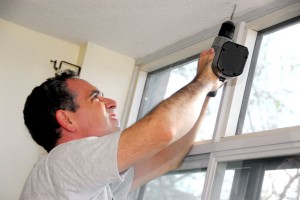Heat escape can cost a home hundreds of pounds a year and there are many systems you can put in place to alleviate the problem, some of which will cost big money. However there are others that you can do yourself in a day or so that will reap dividends – here’s four of the best.
Underfloor heating
Treading on tiles or concrete floor in bare feet on a winter’s morning is enough to make even the hardiest soul yelp. And even in socks the uncomfortable feeling can persist throughout the day.
Installing an interlinked system of pipes or cables to create an underfloor heating system sounds like a laborious and technically difficult task, but there are many advantages – no moving parts should mean that little can go wrong if the system is implemented correctly. It also creates more space, in that the room will have no need for radiators or heaters.
Sites such as The Underfloor Heating Store can advise on the best places to start, or their employees can install the system themselves. The initial cost should pay for itself within a year or two, and it could also place extra value on your home is you sell.
Make your own draught excluders
We’re betting you can remember seeing the classic ‘sausage dog’ draught excluders at your nan’s house, and they do retain a nostalgic air, of times when people were more creative in dealing with issues around the house. The snake shape at the base of a door cuts out heat loss along the entire length, while a weighted doll, cat or dog prevents the doors from swinging open.
You can make your own. Without wishing to destroy your children’s cuddly toys, if they have a ‘heavy’ toy or one which has access to its stuffing (where you can place weights inside) you’ll soon be able to make a toy that’s weighty enough to stop doors movement.
For the more creative, a long sock or set of tights stuffed with socks will do the trick, and your youngsters can help you decorate it with ribbons, lace and the like, perhaps turning it into a snake, lizard or dog.
Insulation
There’s a lot of area in a house to insulate. The roof and loft, cavity walls, floor and tanks pipes and radiators should all be treated/covered to retain heat, and you don’t need to call someone in to do them.
The attic is the easiest part of the house to insulate, and worth doing as 25% of heat loss occurs there, potentially costing even a small bungalow £200 a year.
Any reputable DIY store will stock the mineral wool or insulation boards needed to cover the attic, and then it’s a case of rolling the wool in-between the joists and laying boards on top. Make sure to wear protective clothing. If you don’t wish to do it yourself British Gas and EDF Energy are among the power companies that will carry out the process for you – find out more at Which.co.uk.
A hot water cylinder jacket for a boiler is very easy to install and costs around £15, while the foam insulation for exposed piping keeps water hot for longer. Measure the pipe beforehand using a tape measure.
Putting up curtains
Thick lined curtains keep warm air from escaping the house by essentially blocking movement. In that regard they are also beneficial in the summer in that the sin’s heat is blocked and you may spend less on air conditioning.
There are actually four ingredients to the perfect curtain insulation system, which consists of a decorative layer (available in a variety of styles) and lining , a high density foam that even blocks sound waves (useful if you live in a busy area) , a reflective vapour barrier, and a film that directs heat back into the room.
You could buy them or attempt to make them yourself using online guides such as this eHow article.